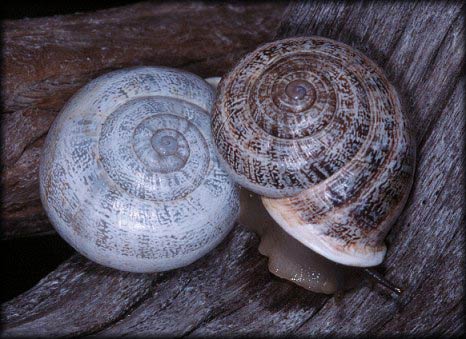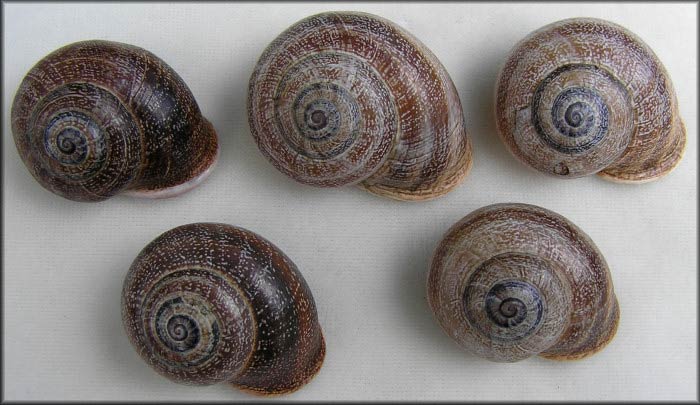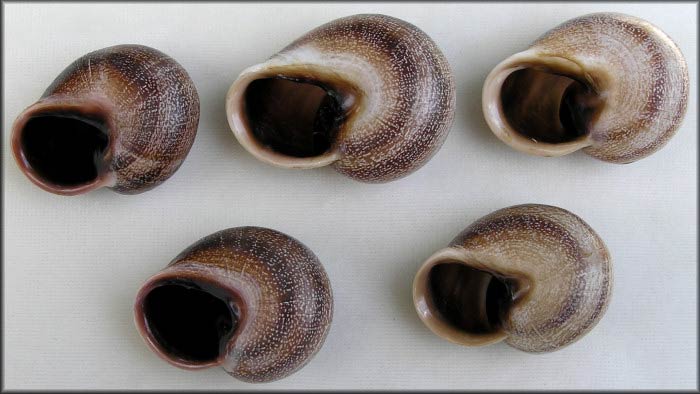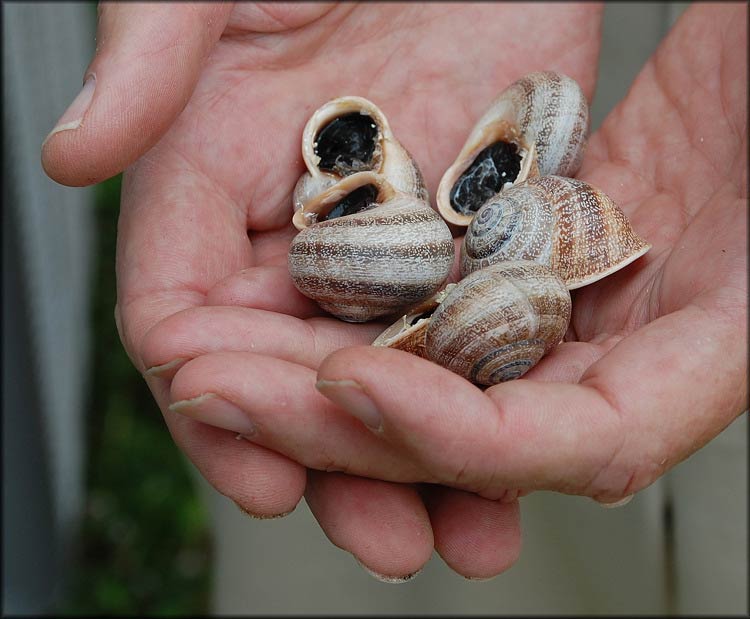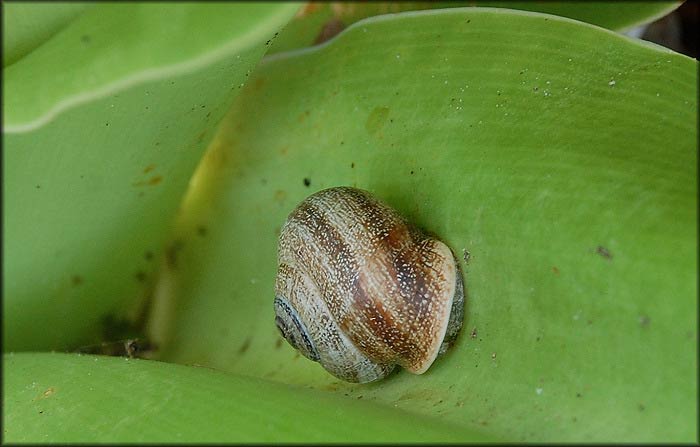Otala spp.
|
Otala lactea and Otala punctata: comparison. (Photo: © B. Frank, Jacksonville) |
|
Otala lactea. (Photo: © D. Robinson, USDA-APHIS-PPQ) |
|
Otala lactea. (Photo: © B. Frank, Jacksonville) |
|
Otala lactea. (Photo: © P. Poland, Jacksonville) |
|
Otala lactea. (Photo: © S. Fraser-Smith, Wikipedia) |
|
Otala punctata. (Photo: © B. Frank, Jacksonville) |
|
Otala punctata. (Photo: © B. Frank, Jacksonville) |
|
Otala punctata. (Photo: © B. Frank, Jacksonville) |
|
Otala punctata. (Photo: © B. Frank, Jacksonville) |
|
Otala punctata. (Photo: © B. Frank, Jacksonville) |
|
Otala punctata: juvenile. (Photo: © B. Frank, Jacksonville) |
Family
Helicidae
Species
Otala lactea (Muller, 1774)
O. punctata (Muller, 1774)
Common name
Otala lactea: Milk snail, Milky snail
Otala punctata: Spanish snail
Description
Otala lactea: The diameter of Otala lactea's shellShell:
A hard, inflexible, calcareous or chitinous structure that vary in size and may either completely encasing the animal, covering some part of it or be internal.
ranges from 27.5 to 36 mm and the heightHeight:
The height of the shell is a measure of the distance between the apex and the most basal part of the shell OR the measurement taken from the apex of the shell to the base, when measured parallel to the axis of the shell.
ranges from 16 to 25 mm. The non-globular, slightly depressedDepressed:
Shrunken below a certain level.
shell is whitish or brownish and has darker stripes that are speckled. These white specks are very close to each other. The discoloration on the shellShell:
A hard, inflexible, calcareous or chitinous structure that vary in size and may either completely encasing the animal, covering some part of it or be internal.
may also be either uniformly distributed or it may posses darker fine or gray mottling in the stripes. The surface of the shellShell:
A hard, inflexible, calcareous or chitinous structure that vary in size and may either completely encasing the animal, covering some part of it or be internal.
is minutely dented or punctuated and has very fine, partly indistinct spiralSpiral:
Directional term: direction of the coils of the whorls of a shell; opposite of axial.
striations. This species has a distinct apertural lipApertural lip:
The margin of the aperture, which may be sharp or thickened depending upon the species (Also see lip).
. The apertureAperture:
The major opening of a shell that the body of the animal may be retracted.
and peristomePeristome:
Margin of the aperture of a snail's shell. This region may be thickened in mature animals.
are liver-brown to black in color. The umbilicusUmbilicus:
A navel-like indentation or depression in the center of the shell. It may be described as open (inside of columella visible), partially closed (partly covered by base of aperture) or completely closed (not visible). The width of the umbilicus is a measure of its greatest diameter.
(navel) is inconspicuous. The body of the animal is tan to grey-brown.
Otala punctata: This species is morphologically similar to O. lactea ; however, O. punctata shell Shell:
A hard, inflexible, calcareous or chitinous structure that vary in size and may either completely encasing the animal, covering some part of it or be internal.
ranges from 33 to 39 mm wide and 20 to 24 mm high.
These species can be separated by:
- O. lactea: A denticular tooth is present on the columellaColumella:
The central axis of the shell; originates at the shell apex and ends at the umbilicus.
of the shellShell:
A hard, inflexible, calcareous or chitinous structure that vary in size and may either completely encasing the animal, covering some part of it or be internal.
. The entire apertural lipApertural lip:
The margin of the aperture, which may be sharp or thickened depending upon the species (Also see lip).
of the opening (mouth) is very dark brown. - O. punctata: Denticular tooth absent. The upper region of the apertural lipApertural lip:
The margin of the aperture, which may be sharp or thickened depending upon the species (Also see lip).
of the opening (mouth) is very pale (tan to white), with the remainder being brown.
Native range
O. lactea: Northern Africa and Spain
O. punctata: Spain and Southern France
Distribution
North America:
- U.S.: Arizona, California, Florida, Georgia, Louisiana, Mississippi, Texas
South America: Argentina
Caribbean: Bermuda, Cuba, Jamaica
Australia
Africa
Europe: Spain
Other: Mediterranean region
Ecology
Otala spp. are noctural foliage feeders. Otala lactea has been reported to feed on papaya, lily, anise, broccoli, cabbage, cauliflower, celery, lettuce and yucca plants. This edible snail is often consumed in the Mediterranean region. The milk snail generally exists in rocky heath lands and steppes. The Spanish snail prefers agricultural areas and coastal plains.
Synonyms
Otala lactea:
- Helix canariensis Mousson, 1872
- Helix ahmarina Mabille, 1883
- Helix jacquemetana Mabille, 1883
Otala punctata:
- Helix punctata (Muller, 1774)
References
Abbott 1989Abbott 1989:
Abbott, R.T. 1989. Compendium of landshells. A full-color guide to more than 2,000 of the World’s terrestrial shells. American Malacologists, Inc., Melbourne, FL and Burlington, MA. pp. 240.; Cowie et al. 2009; Pilsbry 1939Pilsbry 1939:
Pilsbry, H. A. 1939. Land Mollusca of North America north of Mexico vol. I part 1. Academy of Natural Sciences, Philadelphia. pp. 1-574.




